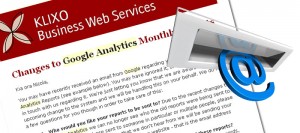E-Newsletters are a cost-effective, powerful tool to increase customer loyalty and sales.
The main benefits of having a well-subscribed newsletter are:
- You have a willing audience - they have subscribed to your newsletter and are therefore interested in hearing what you have to say - this is known as permission marketing.
- You have an excuse to make regular contact with your audience - this keeps you front of mind for them.
- You have the opportunity to highlight special deals, new products, new services, changes in the way you do business etc.
- You have the opportunity to add value to your audience by providing them with relevant information from your field.
- You can easily track who read your newsletter and the number of leads generated from it.
- A good newsletter is often forwarded - providing an easy referral mechanism.
- A newsletter is an excellent source of traffic to your website.
Websites that have good subscriber lists and that send out newsletters regularly do have higher visitor loyalty rates. It is notable that around the time newsletters are sent there will always be spikes in website visits.
Content
One of the hardest things to grapple with when contemplating starting a newsletter is content. What should I write about? What if I have nothing to say this month? What if I can’t write to save myself?
It really doesn’t have to be hard.
First, you don’t have to have a monthly newsletter - you could publish bi-monthly or quarterly. Don't put too much pressure on yourself.
There will always be something happening in your area. It doesn’t have to be related to your particular business. It may just be something that has happened in your field of expertise, or in the product line that you sell. Maybe someone using one of your products just won a world championship, or a magazine featured items from a product line you stock.
Of course you can always generate your own content sources, here are a few ideas which we have seen work well:
-
Notification of winners in a competition
Having a competition is also a great way to build your subscribers list -
Monthly or weekly website deal notifications
Also a good way to grow your subscribers list -
Latest blog posts from the website
If people are interested in the content of the site this is a great way to keep them coming back. -
Keeping in regular contact with your current clients
Let your clients know what is happening in your company - new products, testimonials, client profiles, offers as above, company news, advice for use of your products. -
Special holiday newsletters
During the holiday season these can be a great boost to your revenue.
The key to success with E-newsletters is knowing your subscribers. You need to think about what they want from your newsletter and you should also know what your website can offer them. Not all of the ideas listed above will work on your website and in some cases you could also use any combination of them.
Note that running competitions is a great way to boost subscriber numbers. The competition gives them a reason to sign up, and then they will stay signed up if you continue to deliver relevant content to them.
Gathering Subscribers
Now, the mechanics of how to allow people to subscribe and how to actually send out the newsletter.
It is important to make it clear on your website that you have a newsletter and also what the subscriber can get if they sign up. For example "Sign up to our monthly newsletter and be in to win great prizes!"
To start off your subscriber list you can use email addresses you have already gathered from clients - as long as they gave you permission to use their email for sending occasional messages. If you are not sure whether you have that permission then it is advisable to invite your clients to opt in to the newsletter list (see below for more detail on this). Your newsletter must include information about how to unsubscribe from the list - this is automatically built into the delivery mechanisms we talk about below.
The great thing about subscriber lists is that you can have more than one. You can sort your subscribers into groups (depending on how much information you collect from them) - e.g. interested website visitors, suppliers/clients, competition entrants, repeat customers, people who have birthdays in certain months and so on. Once you have grouped your lists you can target them each with more relevant information - slightly different newsletters.
Sending Newsletters
You send newsletters to your subscriber lists using either third party software or software built into your website.
The third party software we recommend using is MailChimp, or we can provide an email publication system built into your website.
It is important to note that to comply with anti-spam regulations (and to show respect to your customer base) you need to have permission to send newsletters to people. Your newsletter subscription function (sign-up box on your site) should have a double opt-in function. This means that the owner of the email address gets an email asking them to confirm that they signed up.
MailChimp
MailChimp is a purpose-built email marketing service that ranges from free packages that only allow for a limited amount of subscribers and transmissions, through to monthly paid packages to suit your needs.
Features:
- Detailed reporting - MailChimp's free reports give you details about who opened and clicked your campaigns, who forwarded to friends, overall ROI and more.
- Pre-designed templates – this can cut down the cost of your development / design of your newsletter. MailChimp templates are easy to use and modify to suit your needs – e.g. add your Logo to.
- Google Analytics Integration – This allows you to easily track how users are viewing and responding to your newsletter. E.g. Do they get to your website and leave after viewing one page only? Or do they carry on and make a purchase or send an enquiry?
- Autoresponders - Use these to create and schedule automated messages that make your subscribers feel special and encourage engagement.
- List management - You will have more control of your list, MailChimp automatically handles all of your hard bounces and manages your soft bounces. You can track which users are responding to your newsletters and target them specifically if you wish using list segmentation. Another example of list segmentation could be to only send to people who liked a specific product you provide.
MailChimp are constantly adding new features to their system and, as it is a purpose-built Email Marketing system, it is the most powerful system we can offer.
On-site Systems
In the past we have developed our own email newsletter system, and this has and is still working quite effectively. We are now using a system call SimpleNews that automatically ties in with Drupal websites. This system is effective and easy to use, it also allows the editor to not leave their website when wanting to create a new newsletter. Some of the features of the On-site newsletter system are:
- Easy Subscriber Management - mass subscribe/unsubscribe users. Auto manages hard and soft bounces system also
- Google Analytics Integration - Clicks from the newsletter can be tracked in a similar fashion to Mailchimp but the reporting is done in Google Analytics
- Subscription Autoresponders - You can send subscribers a nice message when they subscribe to your list
- Content Selection from your website - when creating newsletters you have the option to add the content from any other node you have created on your website e.g. recent blog posts, deals etc.
Having a competition is also a great way to build your subscribers list









